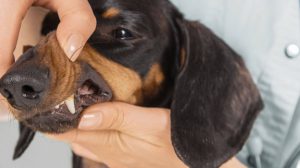It is pretty standard for a dog to develop an abscess. These pus accumulations directly under the skin are usually unproblematic. If they are inside the body, however, it can be dangerous. In any case, a veterinarian should treat the abscess.

If you feel any strange swelling or lumps when petting your dog, it’s often an abscess. Even the most minor injury can allow bacteria into the body that form pus. There are risks associated with opening the encapsulation at home, so have a veterinarian treat the abscess.
Abscess in dogs: These are the possible causes
Especially when romping wildly with other furry friends, your four-legged partner can quickly incur minor injuries such as scratches. Still, bites or insect bites are also potential causes of an abscess in the dog. For example, bacteria found in the oral flora of other dogs get under the skin through the wound. The tissue becomes inflamed, and sometimes there is a lot of pus formation. Over time, the body tries to counteract this and encapsulates pus and wound fluid. The result of this process is called a mature abscess.
Other causes are, for example, operations, dental diseases or diseases of the oral cavity or jaw. They are particularly dangerous because the bacteria can enter organs such as the kidneys via the bloodstream or lymphatic fluid and cause an internal abscess. Only a vet can treat it.
Common symptoms that indicate an abscess
An abscess in dogs initially manifests as an ever-increasing swelling under the skin. You can often still see superficial injuries such as bites, scratches, or scabbed puncture marks. The tissue around the wound is red. A fever can also be a sign of an abscess. The body uses all means at its disposal to fight inflammation. Internal accumulations of pus are usually accompanied by vomiting, lethargy and loss of appetite. The lymph nodes can also be swollen.
Other possible symptoms:
• Tenderness when touched
• Increased warmth around the abscess
• Hair loss
• Small areas of skin dying off due to insufficient blood supply
Abscess in dogs: how do veterinarians treat them?
The vet looks at the abscess in the dog. However, treatment can only occur when the spot is mature, i.e. the capsule around the pus accumulation has closed completely. This can take a while, but medications such as ointments will speed up the process. Painkillers will help your loved one through this time. In some cases, an antibiotic will also be prescribed to counteract the possible spread of bacteria into the bloodstream.
If the abscess is mature, it is treated under local anaesthesia or
General anaesthesia opened so that the pus could drain to the outside. If you treat yourself or not, there is a high risk that the pus will spill inwards. The result is life-threatening blood poisoning (sepsis). If the abscess has ruptured in the dog, the treatment becomes more difficult because now the tissue capsule can no longer be rinsed out with a disinfectant solution after the pus has drained.
The vet must remove pus from all tissues to prevent sepsis. After successful treatment, it is essential to take good care of the wound and keep it clean to deter other bacteria. An antibiotic will help your dog fight the rest of the pathogens inside the body.









